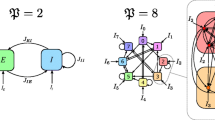Abstract
We investigate the influence of diversity on the temporal regularity of spiking in a ring of coupled model neurons. We find diversity-induced coherence in the spike events, with an optimal amount of parametric heterogeneity at the nodal level yielding the greatest regularity in the spike train. Further, we investigate the system under random spatial connections, where the links are both dynamic and quenched, and in all the cases we observe marked diversity-induced coherence. We quantitatively find the effect of coupling strength and random rewiring probability, on the optimal coherence that can be achieved under diversity. Our results indicate that the largest coherence in the spike events emerge when the coupling strength is high, and when the underlying connections are mostly random and dynamically changing.





Similar content being viewed by others
References
J K Douglass, L A Wilkens, E Pantazelou and F Moss, Nature 365, 337 (1993); Special issue of J. Stat. Phys. 70, 1 (1993) edited by F Moss, A Bulsara and M F Shlesinger H A Braun, H Wissing, K Schäfer and M C Hirsch, Nature 367, 270 (1994) S Kádár, J Wang and K Showalter, Nature 391, 770 (1998) T Wellens, V Shatokhin and A Buchleitner, Rep. Prog. Phys. 67, 45 (2004) K Murali et al, Phys. Rev. Lett. 102, 104101 (2009)
W Horsthemke and R Lefever, Noise-induced transitions (Springer-Verlag, Berlin, 1984) F Sagués, J M Sancho and J García-Ojalvo, Rev. Mod. Phys. 79, 829 (2007)
L Gammaitoni, P Hänggi, P Jung and F Marchesoni, Rev. Mod. Phys. 70, 223 (1998) B Lindner, J García-Ojalvo, A Neiman, L Schimansky-Geier, Phys. Rep. 392, 321 (2004)
D Sigeti and W Horsthemke, J. Stat. Phys. 54, 1217 (1989) G Hu, T Ditzinger, C Z Ning and H Haken, Phys. Rev. Lett. 71, 807 (1993) A S Pikovsky and J Kurths, Phys. Rev. Lett. 78, 775 (1997)
C van den Broeck, J Parrondo and R Toral, Phys. Rev. Lett. 73, 3395 (1994) J García-Ojalvo and J M Sancho, Noise in spatially extended systems (Springer, New York, 1999)
J F Lindner, B K Meadows, W L Ditto, M E Inchiosa and A R Bulsara, Phys. Rev. Lett. 75, 3 (1995); Phys. Rev. E 53, 2081 (1996)
B Hu and C S Zhou, Phys. Rev. E 61, R1001 (2000) C S Zhou and J Kurths and B Hu, Phys. Rev. Lett. 87, 098101 (2001)
R Albert and A-L Barabási, Rev. Mod. Phys. 74, 47 (2002)
D J Watts and S H Strogatz, Nature (London) 393, 440 (1998)
A L Barabási and R Albert, Science 286, 509 (1999)
Z Gao, B Hu and G Hu, Phys. Rev. E 65, 016209 (2001) H Hong, B J Kim and M Y Choi, Phys. Rev. E 66, 011107 (2002) M Perc and M Gosak, New J. Phys. 10, 053008 (2008)
O Kwon and H-T Moon, Phys. Lett. A 298, 319 (2002)
O Kwon, H-H Jo and H-T Moon, Phys. Rev. E 72, 066121 (2005)
J A Acebrón, S Lozano and A Arenas, Phys. Rev. Lett. 99, 128701 (2007)
M Perc, Phys. Rev. E 78, 036105 (2008)
Q Y Wang, Q S Lu and G R Chen, Europhys. Lett. 77, 10004 (2007) D Q Wei and X S Luo, Europhys. Lett. 78, 68004 (2007) Z H Liu and P M Hui, Physica A 383, 714 (2007)
M Shrimali, S Poria and S Sinha, Pramana – J. Phys. 74, 895 (2010)
J F Lindner, B S Prusha and K E Clay, Phys. Lett. A 231, 164 (1997) F Qi, Z H Hou and H W Xin, Phys. Lett. A 308, 405 (2003)
C J Tessone, C R Mirasso, R Toral and J D Gunton, Phys. Rev. Lett. 97, 194101 (2006)
H Chen, J Zhang and J Liu, Physica A 387, 1071 (2008)
M Bazhenov, N F Rulkov, J-M Fellous and I Timofeev, Phys. Rev. E 72, 041903 (2005) R E Amritkar and C-K Hu, Chaos 16, 015117 (2006) A Levina, J M Herrmann and T Geisel, Phys. Rev. Lett. 102, 118110 (2009) M Porfiri Phys. Rev. E 85, 056114 (2012)
A Mondal, S Sinha and J Kurths, Phys. Rev. E 78, 066209 (2008)
A Choudhary, V Kohar and S Sinha, Sci. Rep. (Nature) 4, 4308 (2014)
V Kohar and S Sinha, Chaos, Solitons and Fractals 54, 127 (2013)
M Jiang and P Ma, Chaos 19, 013115 (2009)
V Volman and M Perc, New J. Phys. 12, 043013 (2010)
N F Rulkov, Phys. Rev. E 65, 041922 (2002)
X Pei, L Wilkens and F Moss, Phys. Rev. Lett. 77, 4679 (1996) C Zhou, J Kurths and B Hu, Phys. Rev. Lett. 87, 098101 (2001) Y Shinohara, T Kanamaru, H Suzuki, T Horita and K Aihara, Phys. Rev. E 65, 051906 (2002)
Author information
Authors and Affiliations
Corresponding author
Rights and permissions
About this article
Cite this article
KAMAL, N.K., SINHA, S. Dynamic random links enhance diversity-induced coherence in strongly coupled neuronal systems. Pramana - J Phys 84, 249–256 (2015). https://doi.org/10.1007/s12043-015-0930-y
Published:
Issue Date:
DOI: https://doi.org/10.1007/s12043-015-0930-y




